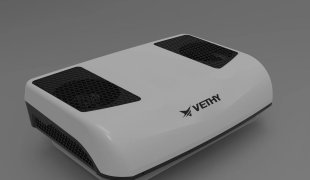A Deep Dive into Parking Air Conditioning Systems for Heavy-Duty Vehicles
November 01, 2024
I. Introduction
The Importance of Parking Air Conditioning Systems
In the realm of heavy vehicles, it's essential for drivers who are on the road for extended periods to have a supportive environment that helps them prepare and ensures their safety. A crucial aspect of achieving this comfort, particularly during the sweltering summer months, is effective temperature management. During this time, the heat in parking lots can become quite oppressive.
Comfort and Safety for Heavy-Duty Vehicle Drivers
Parking air conditioning systems (PACs) are designed to provide cooling while vehicles are parked, allowing drivers to rest without having to run the engine. This not only enhances comfort but also contributes to safety and operational efficiency. With rising temperatures, a reliable PAC can prevent heat-related illnesses and ensure that drivers remain alert and ready for their next journey.
The Evolution of Parking Air Conditioning Technology
Over the years, parking air conditioning technology has evolved significantly. From simple window-mounted units to advanced systems utilizing inverter technology and eco-friendly refrigerants, the options available today cater to a wide range of needs and preferences. Understanding these advancements is crucial for anyone looking to invest in a parking AC system for their heavy-duty vehicle.
II. Technical Features and Performance
Understanding the Core Components
To appreciate the advantages of modern parking air conditioning systems, it’s essential to understand their core components. These typically include compressors, evaporators, condensers, and various controls that work together to provide efficient cooling.
Compressors and Their Role
Compressors are often referred to as the heart of any air conditioning system. They compress the refrigerant gas and circulate it through the system, enabling heat exchange to occur. The type of compressor used can significantly affect the efficiency and performance of the PAC.
Evaporators and Condensers
Evaporators absorb heat from inside the vehicle, causing the refrigerant to evaporate into gas. This process cools down the air that is circulated back into the cab. The condenser, on the other hand, releases this absorbed heat outside the vehicle, allowing the refrigerant to condense back into a liquid state before returning to the compressor.
Performance in Various Climates
High-Temperature Tolerance
Parking air conditioning systems must be able to perform effectively in high-temperature environments. A reliable PAC will maintain comfortable cabin temperatures even when external conditions are extreme.
Low-Temperature Start-Up Capability
Conversely, these systems should also function well in colder climates. The ability to start up efficiently in low temperatures ensures that drivers can enjoy comfort regardless of weather conditions.
III. Environmental Impact and Sustainability
Reducing Environmental Footprint
As environmental concerns grow, so does the importance of choosing sustainable cooling solutions. Modern parking AC systems are designed with eco-friendliness in mind, utilizing refrigerants with low global warming potential (GWP) and ozone depletion potential (ODP).
Energy Consumption and Emissions
The energy consumption of parking AC units directly impacts their environmental footprint. Systems that use less energy not only reduce operational costs but also contribute to lower emissions overall.
Use of Eco-Friendly Materials
Many manufacturers are now focusing on using recyclable materials in their products, further reducing environmental impact throughout the lifecycle of parking AC systems.
Sustainability in Design
Sustainable design practices are becoming increasingly important in HVAC technology. Manufacturers are integrating features that enhance energy efficiency while minimizing waste.
Recyclable Components
By incorporating recyclable materials into their designs, manufacturers can help reduce landfill waste and promote a circular economy within the HVAC industry.
Longevity and Reduced Waste
Durability is another key aspect of sustainability. Long-lasting products reduce waste by decreasing the frequency of replacements needed over time.
IV. Energy Efficiency and Energy Saving
The Role of Energy-Efficient Systems
Energy-efficient parking AC units play a vital role in minimizing operational costs while ensuring effective cooling performance. These systems often feature advanced technologies that optimize energy use based on demand.
Waste Heat Utilization
Some modern PACs utilize waste heat recovery techniques to enhance efficiency further. By capturing excess heat generated during operation, these systems can improve overall performance without requiring additional energy input.
Energy Recovery Techniques
Energy recovery techniques allow for better management of power consumption within HVAC systems. By reusing energy where possible, these methods contribute to significant savings over time.
V. Market Status and Trends
Global Market Overview
The market for parking air conditioning systems has been growing steadily as more drivers recognize the benefits of maintaining a comfortable cabin environment while parked. This growth has led to increased competition among manufacturers, resulting in more innovative products entering the market.
Regional Demand and Growth
Demand for parking AC systems varies by region, influenced by climate conditions and local regulations regarding emissions and energy efficiency standards. Understanding these regional differences is essential for manufacturers looking to expand their market presence.
Technological Advancements
Technological advancements continue to shape the parking AC market. Innovations such as smart controls, inverter technology, and improved refrigerants have made modern systems more efficient than ever before.
Future Projections
As consumer awareness grows regarding environmental issues, we can expect an increase in demand for eco-friendly cooling solutions across all sectors—including heavy-duty vehicles.
VI. Product Features and Innovation
Next-Generation Technologies
The latest generation of parking AC units incorporates cutting-edge technologies designed specifically for heavy-duty applications:
Variable Displacement Compressors
Variable displacement compressors allow for precise control over cooling output based on real-time demand—ensuring optimal performance while minimizing energy consumption!
Electric Compressors for EVs and HEVs
With electric vehicles (EVs) gaining popularity, many manufacturers are developing electric compressors tailored specifically for these applications—providing efficient cooling without relying on traditional fuel sources!
Innovations in Comfort and Control
Modern parking AC units offer advanced temperature control systems that allow users to customize their environment easily:
Advanced Temperature Control Systems
These systems provide users with precise control over cabin temperatures—ensuring maximum comfort during long hauls!
Intelligent Humidity Management
Humidity management features help maintain optimal moisture levels within cabs—enhancing overall comfort while preventing issues related to excess humidity such as mold growth or discomfort!
VII. Safety and Comfort
Enhancing Driver Comfort
Comfort is not just about temperature; it encompasses several factors that contribute positively towards driver well-being:
Climate Control for Alertness
Maintaining an optimal climate within truck cabs helps keep drivers alert—reducing fatigue associated with extreme temperatures!
Ergonomic Design Considerations
Many modern parking AC units are designed with ergonomics in mind—ensuring ease-of-use while minimizing strain during operation!
Safety Implications
Safety should always be prioritized when operating any machinery! Parking AC units equipped with safety features ensure peace-of-mind during use:
Anti-Fogging Capabilities
Some advanced models include anti-fogging capabilities—improving visibility during humid conditions!
Reduced Strain on Vehicle Systems
By utilizing efficient designs that minimize strain on other vehicle components—these systems contribute positively towards overall reliability!
VIII. Applications in Heavy-Duty Vehicles
Long-Haul Trucks and Buses
Parking air conditioning systems are particularly beneficial for long-haul trucks where drivers require comfortable sleeping conditions during rest stops:
Sleeper Cab Comfort
With proper climate control provided by PACs—drivers can enjoy restful sleep without worrying about overheating!
Fuel Efficiency During Rest Stops
By utilizing battery power instead of idling engines—PACs help conserve fuel during breaks while maintaining optimal cabin temperatures!
Construction and Mining Equipment
In harsh environments such as construction sites or mining operations—operator comfort becomes critical:
Operator Cab Climate Control
Effective climate control within operator cabins ensures productivity remains high even under extreme outdoor conditions!
Equipment Durability in Harsh Conditions
Ensuring proper temperature regulation helps extend equipment lifespan by preventing overheating or excessive wear caused by temperature fluctuations!
IX. Maintenance and Repair Considerations
System Reliability and Durability
Reliability is key when it comes down maintaining effective operations across various industries! Regular maintenance ensures longevity:
Maintenance Schedules and Procedures
Establishing routine maintenance schedules allows operators identify potential issues early before they escalate into costly repairs down line!
Component Lifespan and Replacement
Understanding component lifespans enables proactive planning regarding replacements—ensuring uninterrupted service throughout operational cycles!
Cost-Effectiveness of Maintenance
Investing time/resources into preventative measures yields significant cost savings over time! Effective maintenance reduces downtime associated with repairs while prolonging equipment life expectancy overall!
Preventative Measures
Implementing preventative measures such as regular inspections/checks can mitigate risks associated with unexpected failures occurring unexpectedly during peak usage periods!





